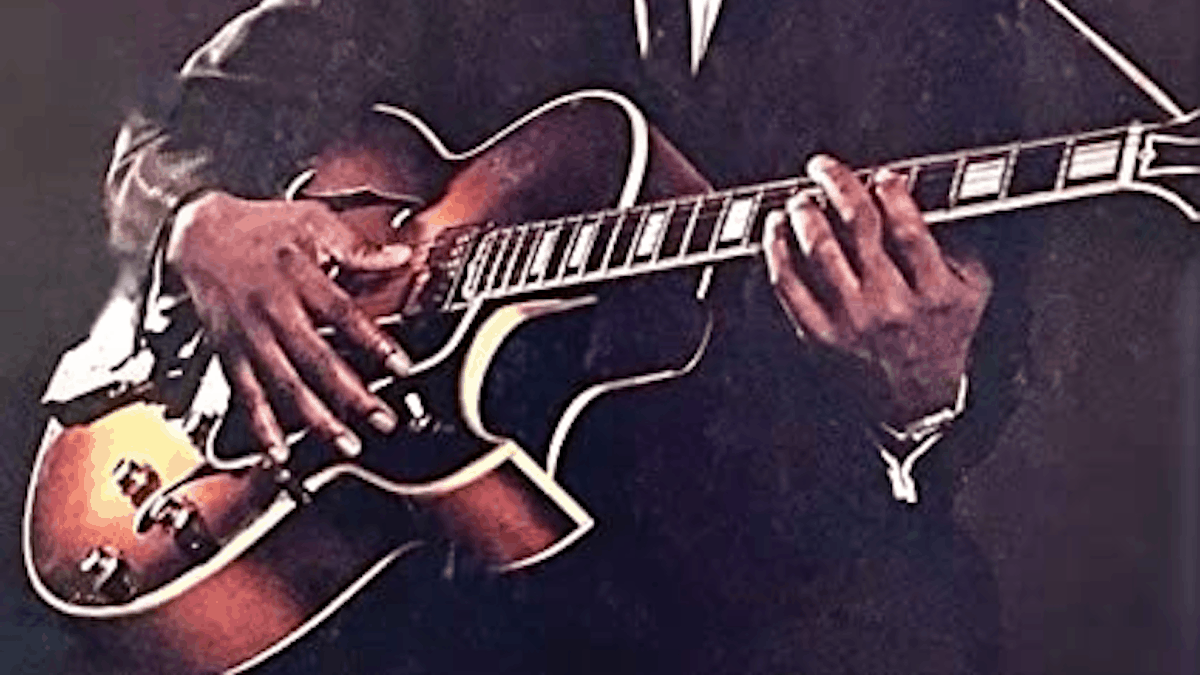Columns
The Wes Factor

Check out this Wes-based upper-string guitar solo lesson based on Mark Stefani’s “Freight Trane” recording.
This lesson is based on one 12-bar chorus from my jazz guitar solo over “Freight Trane” (key of Ab). The tune itself is a tribute to tenor sax legend John Coltrane, composed by pianist Tommy Flanagan and recorded with Trane and guitarist Kenny Burrell on their epic quintet release in the 1950s.
Freight Trane – Lesson by Mark Stefani

Notes & Tips
As the subtitle suggests, this is all about using Wes-style upper-string chord voicings over “Bird’s Blues” (aka “Blues for Alice”) changes. It’s clearly not your standard swing blues. The I and IV chords are both major 7ths, plus there’s back-cycling on display with successive short II-V’s through the first four bars. Check out the minor 7th chords that descend chromatically in bars six through eight leading to the II-V, and finally the melodic III-VI-II-V turnaround.
1 – Harmonically speaking, upper-string chord soloing hinges largely on harmonizing an often simple melody, which is what you see and hear in bar one with movement between the 3rd (C) and 5th (Eb).
That second chord is a 6/9 voicing, which is highly flexible when used in chord solos. Next up is a Gm7b5 picking up a Bb. Bar the upper three strings with your 2nd finger, then shift the voicing up a minor 3rd where it captures the b9 and #9 of the C7 chord.
2 – The next two measures use similar voicings with “call & response” phrasing, but observe how the Fm7 anticipates the beat while the Ebm7 is played right on the beat.
Be aware of these subtle nuances in timing so that your work doesn’t come across as predictable. Observe the use of 9ths over both the Bb7 and Ab7 chords, plus the Ab7#5 that completes the first four bars and sets up movement to the IV chord.
3 – In measure five you’ll see the use of staccato quarter notes with a melody that travels from F to Ab to C before moving into a Dbm9 executed with a slide.
Release the upper tone (Eb) for a conventional minor 7th voicing, then note how the same forms are then used for both the Cm7 and Bm7 chords that follow.
4 – The beat goes on in the 9th measure with the all-important long II-V associated with swing blues progressions.
There
5 – Bars eleven and twelve use symmetrical moves involving standard minor 7th chords with altered dominants, so we have Cm7 to F7b9#5 (aka B9), then Bbm7 followed by Eb7b9#5 (aka A9).
Of more importance is once again the way the sequences are phrased. It’s similar to bars three and four, although this time instead of anticipation the first chord is played after the beat instead of before.
In wrapping this lesson edition up, play this entire chorus “as is” or break it down into separate chord moves that you can use in other scenarios. I’d also highly advise that you spend some time arranging your own solos.
To hear my entire “Freight Trane” solo, click here. A complete transcription (standard notation/tab) is available in our popular Monster Guitar Solo series.
-
Jazz Guitar Lessons2 weeks ago
New JGT Guitar Lesson: Analyzing “Without A Song”
-
Jazz Guitar Lessons4 weeks ago
New JGT Guitar Lesson: Considering “Falling Grace”
-
Artist Features1 week ago
New Kurt Rosenwinkel JGT Video Podcast – July 2024
-
Artist Features2 weeks ago
JGT Talks To Seattle’s Michael Eskenazi




















